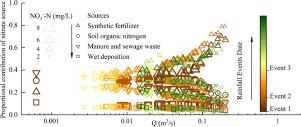Water Research ( IF 12.8 ) Pub Date : 2020-09-03 , DOI: 10.1016/j.watres.2020.116388 Fu-Jun Yue 1 , Si-Liang Li 2 , Susan Waldron 3 , Zhong-Jun Wang 4 , David M Oliver 5 , Xi Chen 2 , Cong-Qiang Liu 2

|
Understanding where nitrate is mobilized from and under what conditions is required to reduce nitrate loss and protect water quality. Low frequency sampling may inadequately capture hydrological and biogeochemical processes that will influence nitrate behavior. We used high-frequency isotope sampling and in-situ nitrate sensing to explore nitrate export and transformation in a karst critical zone. Nitrate was mobilised during light rainfall, and transferred from soil layers to the karst matrix, where some nitrate was retained and denitrified. Nitrate isotopic composition changed rapidly during the rising limb of events and slowly during the falling limb. The main nitrate source was synthetic fertiliser (up to 80% during event flow), transported by conduit flow following high rainfall events, and this contribution increased significantly as discharge increased. Soil organic nitrogen contribution remained constant indicating at baseflow this is the primary source. Isotope source appointment of nitrate export revealed that synthetic fertilizer accounted for more than half of the total nitrate export, which is double that of the secondary source (soil organic nitrogen), providing valuable information to inform catchment management to reduce nitrate losses and fluvial loading. Careful land management and fertilizer use are necessary to avoid nitrate pollution in the karst agroecosystem, for example by timing fertilizer applications to allow for plant uptake of nitrate before rainfall can flush it from the soils into the karst and ultimately into catchment drainage.
中文翻译:

降雨和导管排水共同促进了喀斯特农业生态系统中硝酸盐的流失:稳定的同位素示踪和高频硝酸盐感应提供了见识。
了解减少硝酸盐流失和保护水质的硝酸盐从何处以及在什么条件下被迁移。低频采样可能不足以捕获会影响硝酸盐行为的水文和生物地球化学过程。我们使用高频同位素采样和原位硝酸盐感测来探索岩溶临界区的硝酸盐输出和转化。硝酸盐在小雨期间动员起来,并从土壤层转移到岩溶基质中,在其中保留了一些硝酸盐并反硝化。硝酸盐同位素组成在事件的上升过程中迅速变化,而在下降的过程中缓慢变化。硝酸盐的主要来源是合成肥料(在事件过程中高达80%),在降雨严重时通过导管流进行运输,随着排放量的增加,这种贡献显着增加。土壤有机氮贡献保持恒定,表明在基流处这是主要来源。硝酸盐出口的同位素来源指定显示,合成肥料占硝酸盐总出口的一半以上,是次要来源(土壤有机氮)的两倍,为指导流域管理以减少硝酸盐损失和河流负荷提供了有价值的信息。为了避免喀斯特农业生态系统中的硝酸盐污染,必须谨慎地进行土地管理和使用化肥,例如,通过定时施肥以使植物吸收硝酸盐,然后降雨才能将其从土壤冲洗到喀斯特,最终排入集水区。土壤有机氮贡献保持恒定,表明在基流处这是主要来源。硝酸盐出口的同位素来源指定显示,合成肥料占硝酸盐总出口的一半以上,是次要来源(土壤有机氮)的两倍,为指导流域管理以减少硝酸盐损失和河流负荷提供了有价值的信息。为了避免喀斯特农业生态系统中的硝酸盐污染,必须谨慎地进行土地管理和使用化肥,例如,通过定时施肥以使植物吸收硝酸盐,然后降雨才能将其从土壤冲洗到喀斯特,最终排入集水区。土壤有机氮贡献保持恒定,表明在基流处这是主要来源。硝酸盐出口的同位素来源指定显示,合成肥料占硝酸盐总出口的一半以上,是次要来源(土壤有机氮)的两倍,为指导流域管理以减少硝酸盐损失和河流负荷提供了有价值的信息。为了避免喀斯特农业生态系统中的硝酸盐污染,必须谨慎地进行土地管理和使用化肥,例如,通过定时施肥以使植物吸收硝酸盐,然后降雨才能将其从土壤冲洗到喀斯特,最终排入集水区。硝酸盐出口的同位素来源指定显示,合成肥料占硝酸盐总出口的一半以上,是次要来源(土壤有机氮)的两倍,为指导流域管理以减少硝酸盐损失和河流负荷提供了有价值的信息。为了避免喀斯特农业生态系统中的硝酸盐污染,必须谨慎地进行土地管理和使用化肥,例如,通过定时施肥以使植物吸收硝酸盐,然后降雨才能将其从土壤冲洗到喀斯特,最终排入集水区。硝酸盐出口的同位素来源指定显示,合成肥料占硝酸盐总出口的一半以上,是次要来源(土壤有机氮)的两倍,为指导流域管理以减少硝酸盐损失和河流负荷提供了有价值的信息。为了避免喀斯特农业生态系统中的硝酸盐污染,必须谨慎地进行土地管理和使用化肥,例如,通过定时施肥以使植物吸收硝酸盐,然后降雨才能将其从土壤冲洗到喀斯特,最终排入集水区。



























 京公网安备 11010802027423号
京公网安备 11010802027423号